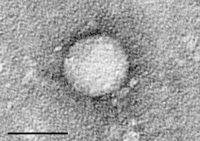
Photo from wikipedia
Recent research from a drug treatment setting in Milton Keyes, UK, highlights the utility of rapid hepatitis C virus (HCV) point of care testing (POCT) for primary care settings for… Click to show full abstract
Recent research from a drug treatment setting in Milton Keyes, UK, highlights the utility of rapid hepatitis C virus (HCV) point of care testing (POCT) for primary care settings for people who inject drugs (PWID) (Mital & Govender, 2016). Testing of 20 people attending this treatment service found that half of those who were unaware of their HCV status for HCV showed lifetime exposure to HCV. Not surprisingly, all of the people who tested positive to HCV antibodies had a history of injecting drug use Mital and Govender (2016). But it must be highlighted that the OraQuick® POCT is at this stage just a test for anti-bodies to HCV—it does not test for active virus. The authors state that “oral POCT [was] an agreeable, non-invasive and painless way to ascertain HCV status.” However, to be certain that someone is currently HCV positive, an RNA test must be performed which requires follow-up blood tests. Hopefully, the post-test discussions conducted as part of this testing initiative included information about the possibility that participants may not actually have current virus. Accurate information about current HCV status together with access to sterile injecting equipment is essential for reducing transmission (Aspinall et al., 2014). The experience of participants in our research with PWID highlights that spontaneous clearance of HCV is not unusual and that reinfection with HCV can also occur (Sacks-Davis et al., 2013). Referral for further specialist management will inevitably ensure these tests are conducted but attending for management and follow-up cannot be guaranteed even in low threshold settings like primary care (Newman et al., 2013; Linas et al., 2014). The development of POCT to establish viral load and whether or not HCV is a current or previous infection are important in settings like the drug treatment setting described; however, they remain “in the pipeline” (Johannessen, 2015). Some (including the World Health Organisation) (Scott et al., 2016) suggest that recent advances in effective treatment of HCV mean that elimination is an achievable albeit ambitious goal. The development of POCT for HCV will be invaluable not only in low threshold settings like drug treatment but also in resource-limited settings where determining whether people are currently chronically infected with HCV will enable treatment with effective medications.